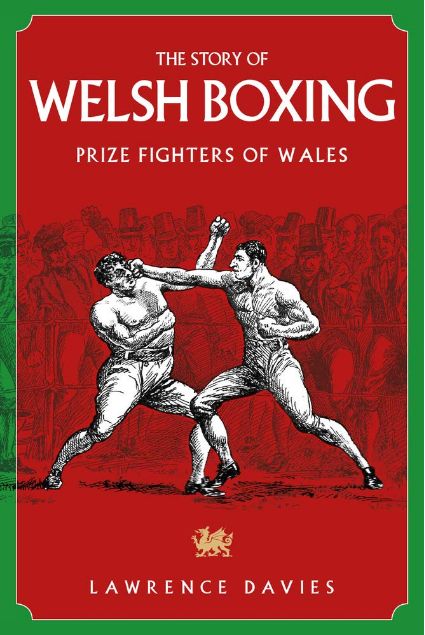The Story of Welsh Boxing: Prize Fighters of Wales
by Lawrence Davies
BOOK REVIEW by John Ochs
With his latest book, The Story of Welsh Boxing: Prize Fighters of Wales, Lawrence Davies traces the development of pugilism in Wales back to a time when exhibitions of “prize fighting,” as opposed to “boxing,” employed cudgels, staffs, and other implements of warfare in addition to the bare fist. This book is his third in what might be called a continuing series of travelogues-in-time which transport readers back through the entire history of Welsh boxing. His first book, Mountain Fighters: Lost Tales of Welsh Boxing covers the period of bare-knuckle boxing from the mid-1800s up to the end of the bare-knuckle age around 1890. His second book, Jack Scarrott’s ‘Memoirs of A Welsh Boxing Booth Showman’, bridges the transition from bareknuckles to the beginning of the modern gloved era as told through the career of the boxing booth operator who discovered world champions Jem Driscoll, Jimmy Wilde, and Percy Jones.
Davies’ third book covers roughly the era from 1700 to the end of Great Britain’s Regency period in 1837. The men profiled in this volume represent the very first heroes of Welsh boxing. Although they were never recognized as world or even British champions, they were the local idols who excited the Welsh public and nurtured the regional pride which would later produce the great Welsh boxers of the early 20th Century and beyond. Prominent among the pugilists rescued from obscurity are the fearless Thomas (Paddington) Jones, remembered for his game 16-round stand against the legendary Jem Belcher; likable Ned Turner, first national sports hero of Wales, who was recognized as the second greatest lightweight in Great Britain after champion Jack Randall; brash William Charles, of Newport, who was the first person to promote himself as “the champion of Wales”; and the ferocious Jack Rasher, the Welsh butcher, who was nicknamed “Ironface” because of his gameness and courage.
Readers familiar with the history of the London prize ring will appreciate the author’s deft interjection of tales about such famous bare-knuckle luminaries as Belcher, Jack Broughton, and Daniel Mendoza. Rather than just name-dropping, the author integrates them into the narrative so their appearances flow naturally from the story. For example, we learn that not only was Broughton regarded as the greatest bare knuckle boxer in the first half of the 18th century, but he was known to have promoted several contests involving Welshmen at his amphitheatre on Oxford Road, London. We also learn Mendoza was the first major pugilist to cash in on boxing’s popularity in Wales with his four-month tour of the country in 1797.
In his coverage of ring action, Davies manages to straddle the correct side of the line between lively description and excruciating detail. Despite stylistic differences, his blending of old-time quotes with modern narrative avoids jarring the reader. Though the bouts occurred 200 years ago, his descriptions are fresh and convincing. His respect for the boxers is evident, but he does not sugarcoat the brutality of the era. He approaches the issue objectively and allows readers to make up their own minds.
Davies also discusses the culture of hero worship among the Fancy, including descriptions of the dinners and presentations by members of the Daffy Club at the Castle Tavern where peers and lords mixed freely with leading members of the fistic fraternity. An entire chapter is devoted to a discussion of “songs of blood and glory” written by Pierce Egan in his famous Boxiana.
Since newspapers did not exist in Wales during the early part of the 19th century, first-hand accounts of many of the events described in the book were not preserved. As a result, the author has pieced together fragments of information from other sources. In those cases where alternative versions of an event were recorded, he has meticulously cross-checked each version and noted the differences in footnotes. The book is smartly illustrated, well researched, and thoroughly documented with a bibliography and a full complement of footnotes and appendices. An index would have been a nice feature for researchers, but is probably not necessary for most readers. The book is a valuable addition to our knowledge of a neglected piece of boxing history and should be of considerable interest to those interested in the sport.
The Story of Welsh Boxing is available from Amazon, Waterstones, WH Smith, and other bookshops. Read more about the book at Pitch Publishing
John Ochs is the author of ‘The One is Jack Hurley’, the acclaimed 3 volume bio-history of the Golden Age of US boxing, from Jack Dempsey in the 1910’s to George Foreman in 1970, as filtered through the life of the renowned boxing manager and promoter Jack Hurley.
